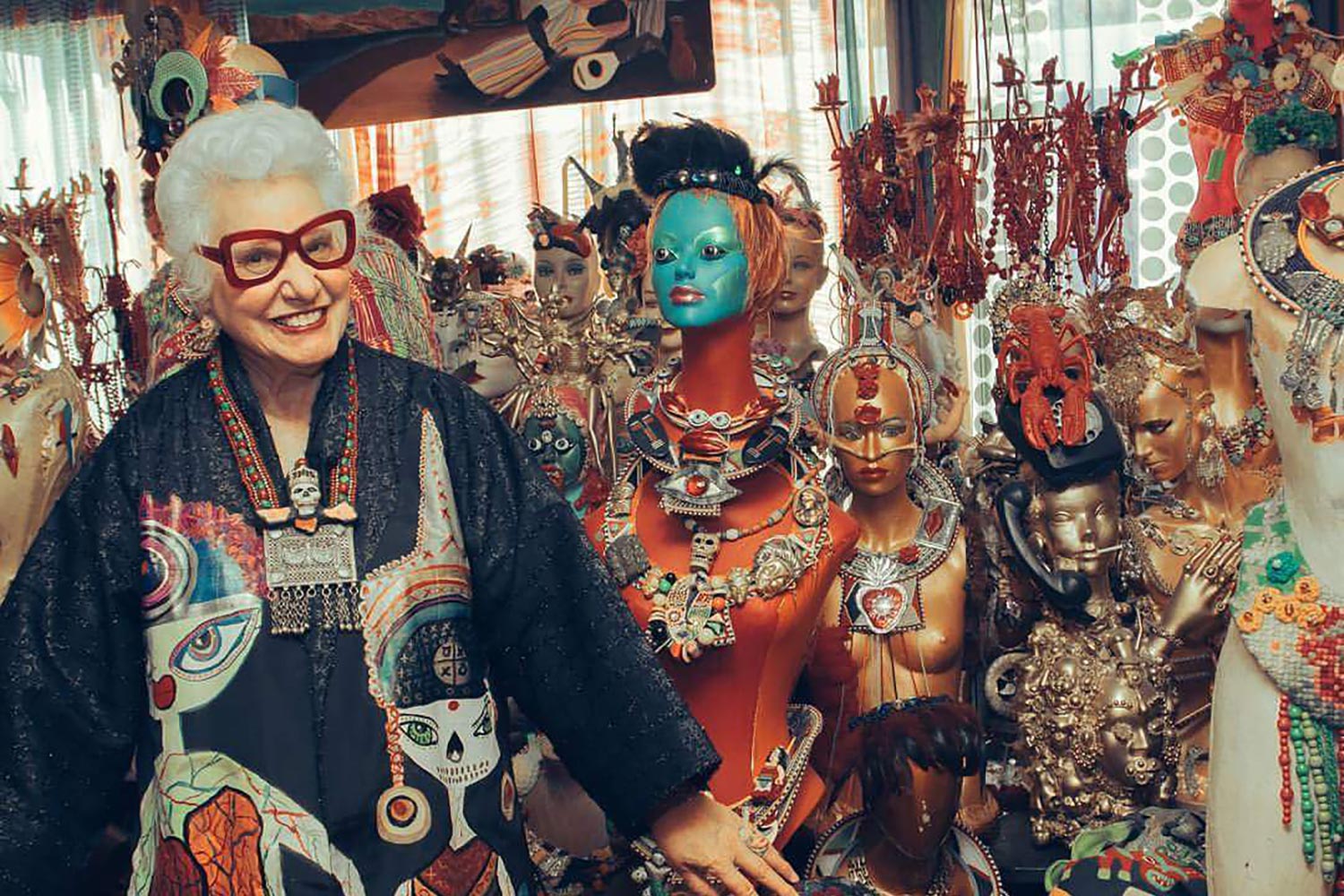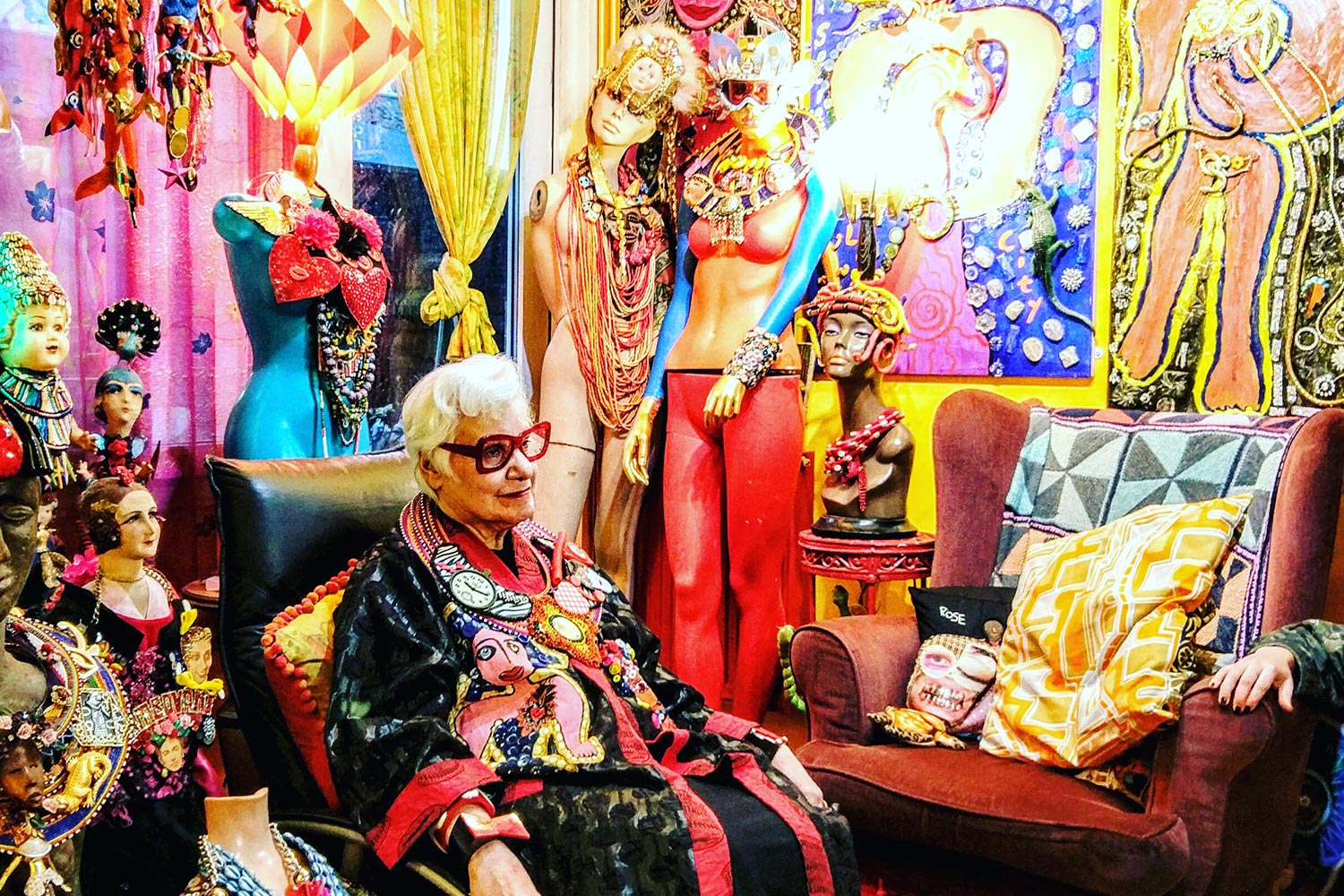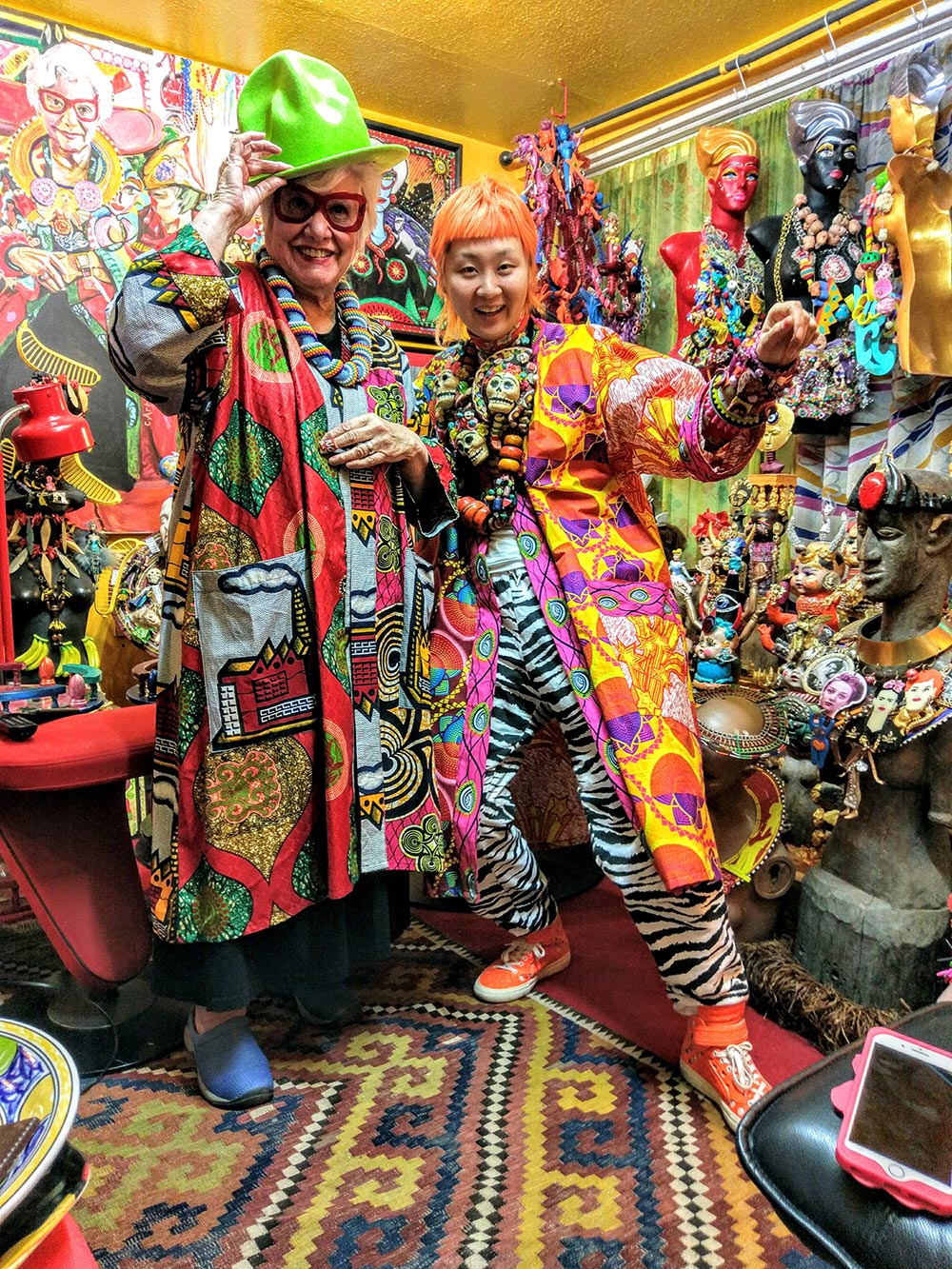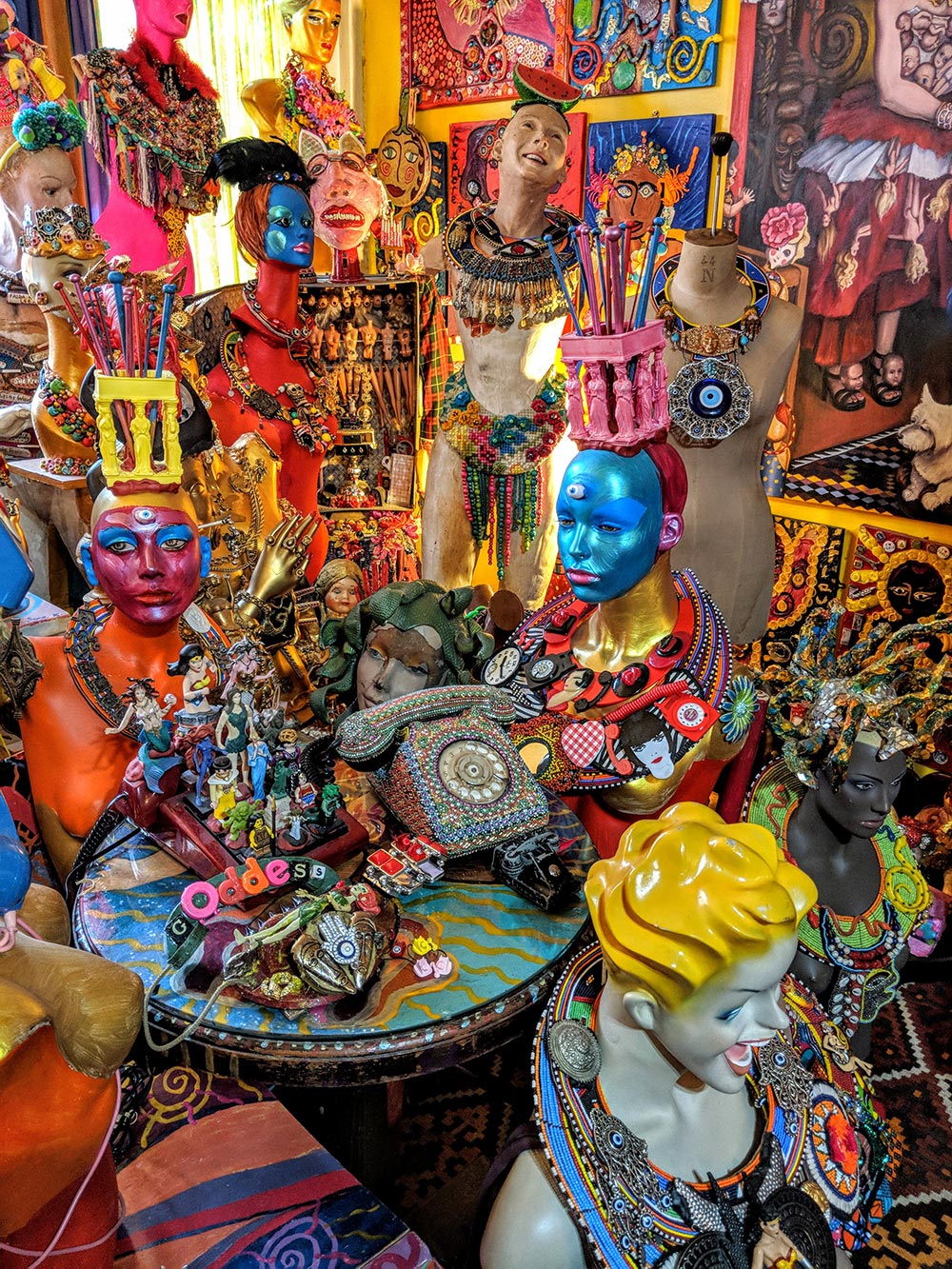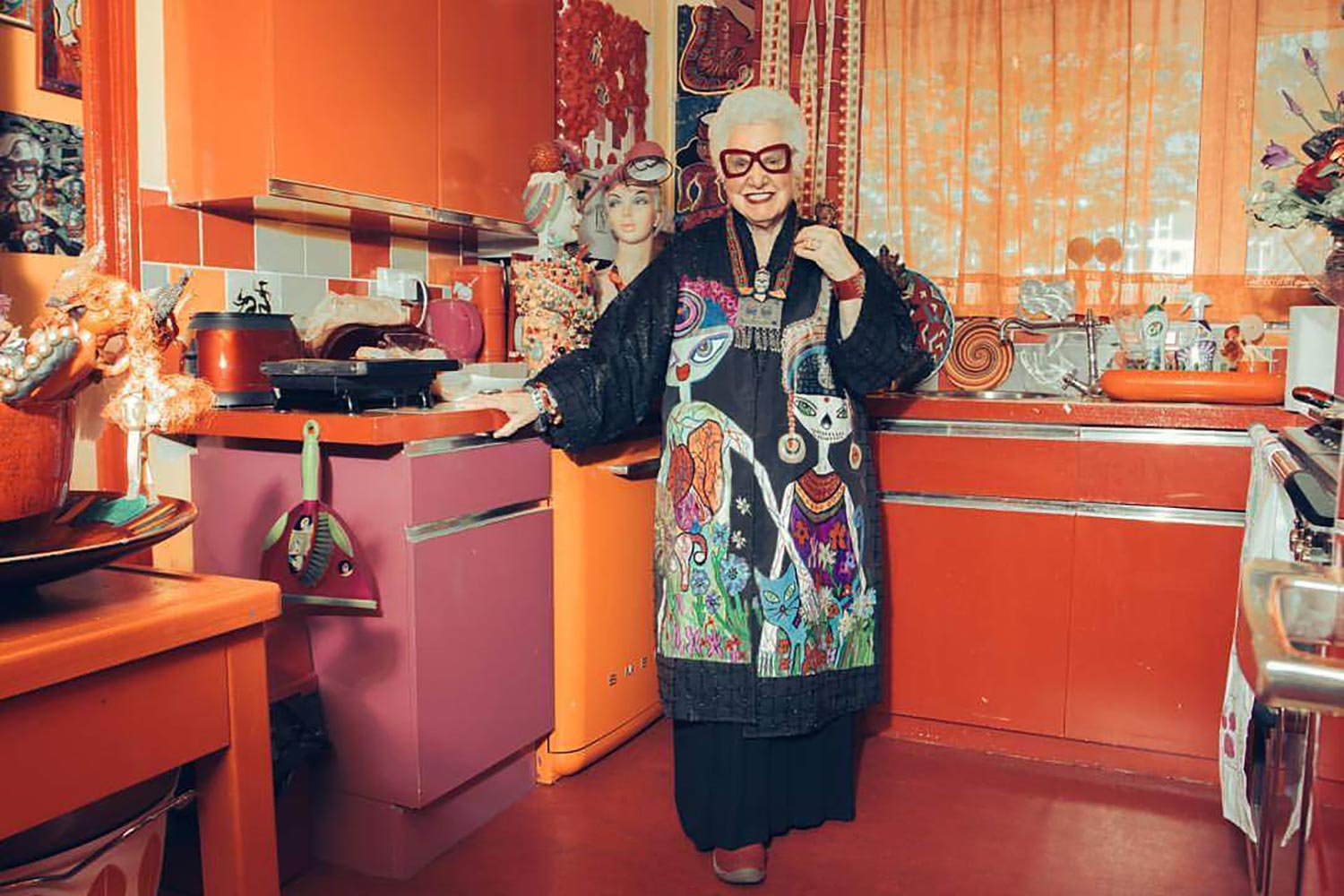Why artist Sue Kreitzman made Bow her home
Sue Kreitzman’s CV is almost as colourful as her living room. She funded her college degree by playing her oboe, cooked a soufflé live on the BBC, wrote 27 cookbooks, set a chicken breast alight on Good Morning Britain, served garlic-flavoured desert at a book launch, moved her living room into a Selfridges shop window, starred in Channel 4’s Fabulous Fashionistas, and now is the proud owner of a shed full of dolls’ heads.
Around 20 years ago, and after a distinguished career as a TV chef, Kreitzman had a moment of clarity. She needed to be an artist. With just one look at her house near Roman Road, you can see why.
The walls are varnished in red and yellow and meet the ceiling like a rubik’s cube. There are mannequin bodies covered in glittery buttons and necklaces dripping with dolls. There are chandeliers swinging with Barbies and porcelain heads covered in plastic diamonds. In Kreitzman’s house, the art folds in on you. It’s a different world.
‘I’ve built my own artist’s environment here,’ Kreitzman says. ‘It is literally another planet, it’s the art planet. You should see it when the sun is shining, it’s dazzling.’
Kreitzman’s home is one giant installation. Previously a council house, she began working on it 23 years ago. She tells me that Bow is a place where she can be a wild, subversive outsider. But what it is about the East End that gives artists oxygen? What is it in Roman Road’s water?
Fitting in
Having grown up in Manhattan, Kreitzman and her husband moved to the UK 36 years ago. They initially lived in a small village in Cambridgeshire but, she says, it didn’t suit her at all.
‘They thought I was so weird, oh my God,’ Kreitzman remembers. ‘It was a fantastic place to live if you raced horses, bet on horses, or if you actually were a horse. But for me, it was an awful fit.’ After her son left to go to university, Kreitzman decided to move to London, and came straight to Bow.
The room she rented on Roman Road was through a junk shop, past an old oven (it used to be a Jewish bakery), and into the house at the end of the backgarden. Kreitzman was in love.
‘It was a death trap, completely illegal,’ she says. ‘It was so weird and completely bohemian. I’m not a spiritual person but I walked in there and I felt like I belonged. I knew the East End was for me.’ Soon after, she found her current home, tucked away on an estate behind the Roman.
‘I bought it for absolutely nothing because nobody wanted to live here, but I thought it was the most wonderful place,’ says Kreitzman. ‘I love this estate.’ Then, Kreitzman had her awakening.
While correcting the proofs of her 27th cookbook (‘probably 27 is enough’), Kreitzman picked up a marker pen and drew a folk-art mermaid. ‘I looked at the mermaid and the mermaid looked at me and my life changed entirely. She was in charge.’
Kreitzman continues: ‘I was drawing day and night, I became completely obsessed. Then I started colouring in my drawings, then I found on the Roman Road market all these glittery, colourful nail varnishes and I started painting with those, with the tiny little brush.’
Adored by the kids on the estate (most of whom have grown up), Kreitzman would make things with them in the living room, or leave art supplies for them in her front garden if she was out. The children also used to give her their old toys, which are now sculptures, wall hangings and neckpieces.
‘I tried to make the the kids hold onto their toys, but no, no, no. I’ve got Barbies, Ninja Turtles – bags and bags of this stuff. I need another apartment, I need another shed, I need another universe,’ Kreitzman crescendos. ‘But nowhere is big enough. Whatever space I have I’ll fill it up.’
If her materials aren’t given to her by a neighbour, they come from a local flea market, charity shop or junk store. Her art is built from the East End’s offcuts. Old mannequins found in skips, biscuit rappers, buttons, bejewelled telephones.
Does she ever throw anything away? ‘Very rarely. In fact, no.’ Even the kitchen is filled with assemblage art (‘I can’t do as much cooking as I used to’). But bizarrely, everything seems to fit. ‘I’m constantly collecting. I’ll see something and think, I have no idea what I’m going to it for, but I’ll know one day it’ll be exactly what I need,’ she says.
Kreitzman has always loved Brick Lane market, which was ‘very seedy’ when she first moved here. ‘I loved it then. The market was all along the pavement and it was full of junk. There was nothing chic about it. That’s my idea of heaven.’ Roman Road market has always been one of her favourite resources and still has, she says, ‘a real flavour of the East End’.
But it is the area’s diversity and heritage that Kreitzman loves the most. She remembers her dry cleaner on Roman Road taking its sign down, and underneath the wall reading ‘Goldberg’s Smoked Fish’. She remembers: ‘You could see the Jewish history – just peel away the layers and it’s right there. I hope we don’t lose the old flavours.’
Powerful women
It seems as if reincarnation is constantly on Kreitzman’s mind. With her art, she aims to take something old, something that people don’t want anymore, and give it a new life. A particular obsession of hers is the rebirth of Barbies, which are suspended throughout the house, blue haired and soaring through the air.
‘I’m interested in powerful women, women as goddesses,’ she says as she sits among her tribe of glittering heroines. ‘In a flea market I found a box of bowling pins shaped like very voluptuous female figures, and they didn’t have any heads. I thought, that’s the most sexist thing I’ve ever seen in my whole life. So I bought them.’
Today they stand behind where she sits, now with dolls’ heads and piles of decoration around their necks. ‘We took that very sexist thing and we turned it around. They’re now all very powerful, avenging goddesses. To hell with the guy who carved these things. We have established their power.’
The longer you look at Kreitzman’s walls, the more women appear from them. You’ll find Medusas (‘she had bad press’), The Little Mermaid’s Ursula (made into a hat), a mermaid with a teacake wrapper for a tail, and a Mexican Wonder Woman. Despite exhibiting across the world, she rarely sells her work because for her, its value lies in it as a collection.
Outsider Artists
Kreitzman is constantly making and constantly searching. Once a month, without fail, she meets the Colour Tribe at Spitalfields Market. They are a group of East London artists, who perform, wear or make their art, working ‘way outside the box’.
‘It is a great feeling of camaraderie, that as weird as you might be – because none of us are pretending, this is all who we are – there are other people like us,’ Kreitzman tells me, also talking about her role as a mentor to younger Outsider Artists.
Despite being a New Yorker, Kreitzman can’t imagine living anywhere else but Bow. ‘The East End of London is the real world for me. That’s where I can be who I am – where I can have this freedom of expression and this wild, colourful creativity.’
The world outside Kreitzman’s front door might look grey, but it helped form the world inside it. ‘The thing about living in the East End is you can be who you are,’ she says, as she sends me on my way with a Suffragette doll from her shed. ‘You have people of all colours, all races, all sizes, all genders – whatever we are, we’re all part of London’s East End life.’
If you liked this you might also like to read about Jo Behari, DIY Queen of Bow.
If you liked this you might also like to read about The Lost Stories of Bow’s Suffragettes
